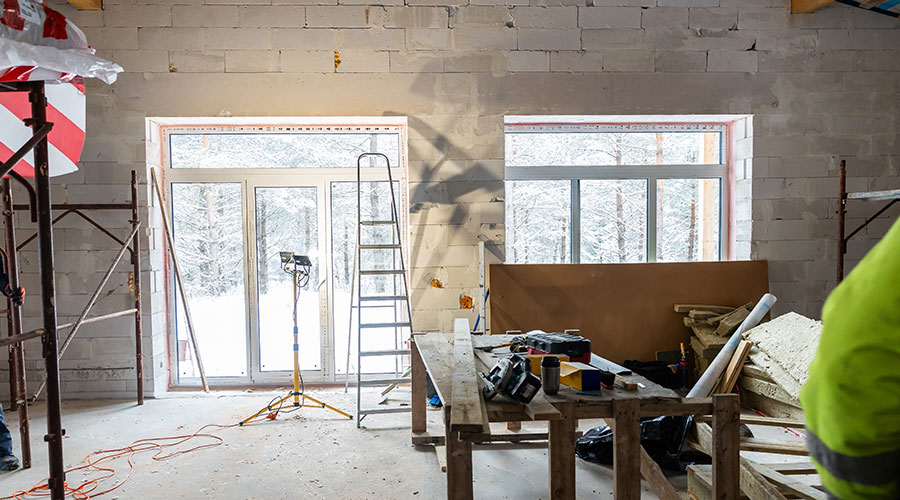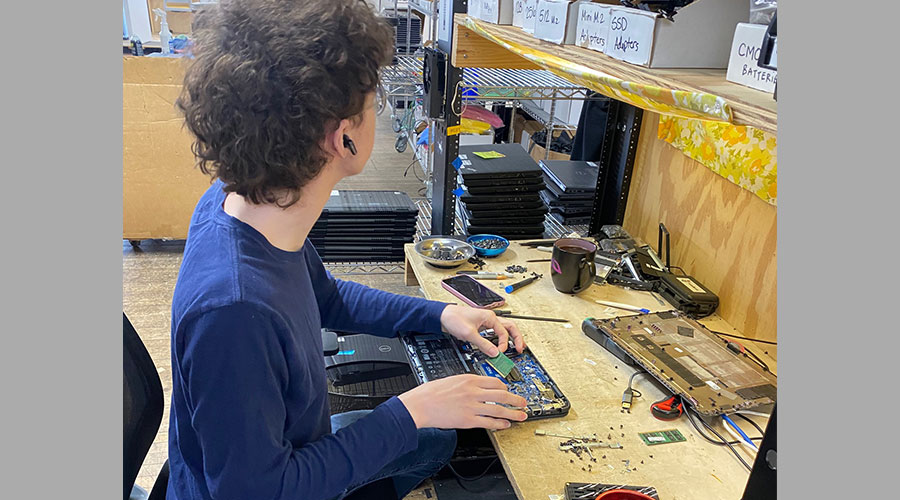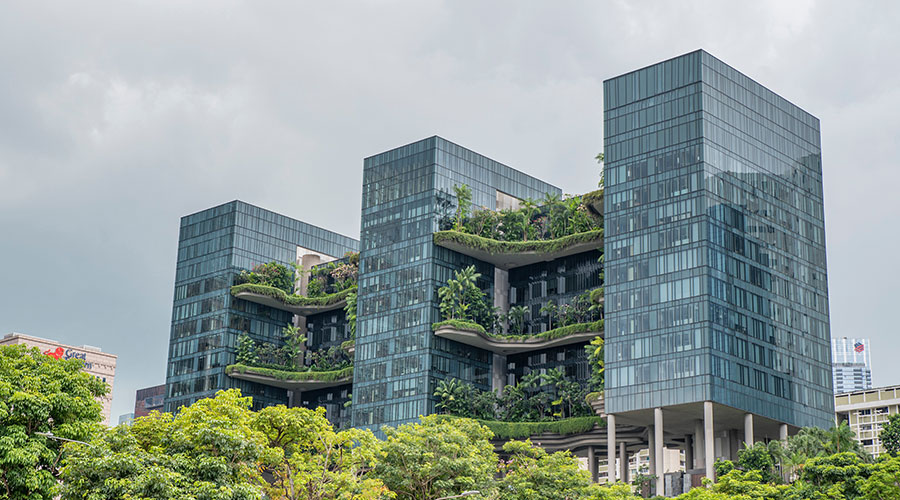LEED: A Scorecard for Green Buildings
Understanding how the LEED rating system works can help facility executives shape green buildings
By Greg Zimmerman, Executive Editor
Report prepared in conjunction with the U.S. Green Building Council
Throughout its relatively short life, the green building movement has been constantly questioned. Won’t a green building cost more? Is the extra cost worth it? Will a green building last as long? Isn’t this whole thing just a fad?
But the hardest question green building advocates have had to answer is the most fundamental one: What exactly is a green building?
The Leadership in Energy and Environmental Design (LEED) green building rating system is the U.S. Green Building Council’s (USGBC) attempt to provide a nationally recognized answer to that question. LEED seeks to define “green building” by standardizing it with a list of specific criteria that cover a range of building performance issues and their impact on the environment.
Even though LEED has become a cornerstone of sustainable design, the standard itself remains enigmatic to some facility executives. For them, an understanding of the points, certification process, challenges and benefits of LEED is an essential start to the process of incorporating LEED into their organizations’ projects.
Even if a green building is not LEED-certified, LEED still provides a framework for sustainable design. That’s because LEED takes a careful look at almost every aspect of building design and promotes integrated design from a project’s beginning. This holistic yet user-friendly approach is why LEED is becoming increasingly popular among facility executives in particular.
“LEED gives facility executives a place of honor at the table,” says S. Richard Fedrizzi, president, CEO and founding chairman of USGBC. “LEED relies on the experience of the facility executive’s intimate knowledge of building systems.”
Because LEED applies to most commercial and institutional building types, from hospitals to laboratories to office space, the standard has become popular in just about every nook and
cranny of the industry. Opinions of LEED are generally positive, even across a wide range of professional groups, including architects, engineers, contractors, facility executives, manufacturers and consultants. Usually, the only criticisms aimed at LEED are based on disagreements with individual credits, not at the standard as a whole.
“USGBC has done an excellent job of evaluating a building’s effect on the environment,” says Chris Hodges, president of Facility Engineering Associates.
“No other system quantifies green building as effectively as LEED,” says Gary Saulson, director of corporate real estate for PNC, a Pittsburgh-based financial services company. “LEED has become the benchmark of environmentally friendly building.”
Despite its wide acceptance, for many facility executives, LEED generates as many questions as it does answers. How does it work? Why has it become so popular? What is the potential benefit to my organization?
Answering those questions begins by examining the standard itself and how it works to define green buildings.
Breaking It Down
LEED for new construction and major renovations (LEED-NC) has evolved steadily since the original version was released in 1999. LEED-NC 2.1, the third full version, is the most current, though a new version is scheduled for release in late 2005. Several other LEED products, including LEED for existing buildings (LEED-EB) and LEED for commercial interiors (LEED-CI), are in various stages of development. To date, more than 120 projects have been LEED-certified and more than 1,200 are LEED-registered — that is, signed up to go through the formal LEED-certification process.
The LEED-NC standard includes 69 possible points awarded for use of a variety of sustainable design strategies. Projects earn a certification level based on the number of LEED points the building achieves: Certified at 26 to 32 points; Silver at 33 to 38 points; Gold at 39 to 51 points; and Platinum at 52 to 69 points.
In addition to the 69 possible points, there are seven prerequisites that must be completed for the project to achieve any level of LEED certification. These prerequisites include commissioning of the building’s fundamental elements and systems, CFC reduction, storing and collecting recyclables, and controlling tobacco smoke.
Together, the 69 possible points and the seven prerequisites are grouped into six categories: Sustainable Sites (14 points), Water Efficiency (5 points), Energy and Atmosphere (17 points), Materials and Resources (13 points), Indoor Environmental Quality (15 points) and Innovation and Design Process (5 points).
The first five categories contain points awarded for specific sustainable design strategies. Sustainable Sites Credit 7.2, for instance, specifies that one point is earned if at least 75 percent of the roof surface is Energy Star-compliant and has an emissivity of 0.9, or 50 percent of the roof is a vegetated surface. The intent of this point is to reduce urban heat islands. Other points are less prescriptive. Energy and Atmosphere Credits 2.1, 2.2 and 2.3, for example, provide points for renewable energy technologies: one point for 5 percent of the building’s use, another point for 10 percent and a third point for 20 percent.
With the exception of Energy and Atmosphere Credit 1, every other LEED Credit is worth a single point toward the certification rating. For Energy and Atmosphere Credit 1, though, a project can earn between one and 10 points based on the extent to which it uses less energy than allowed by ASHRAE 90.1-1999. For instance, if a new building uses 45 percent less energy than specified in the ASHRAE standard, it will earn seven points; if it uses 50 percent less energy, it earns eight points.
The Innovation and Design process category is also different than the other five. Up to four points can be achieved for demonstrating green design strategies beyond those specified in the rest of the LEED standard. This allows a little flexibility and lets the project team get creative. Innovation and design process credits have been earned for strategies such as using 100 percent renewable energy, exemplary performance in wastewater treatment, exemplary use of recycled materials and exemplary performance in other areas of LEED. Additionally, Innovation and Design Credit 2.1 awards one point for a LEED-accredited professional being a principal participant in the design and construction process. Becoming a LEED-accredited professional requires passing an exam written by USGBC that tests knowledge of green building principles in general and LEED specifically.
Though Innovation and Design Credit 2.1 is the only point achieved by 100 percent of LEED-certified projects, according to USGBC, several other points are popular as well. For instance, Indoor Environmental Quality Credits 4.1, 4.2 and 4.3, which mandate low-emitting adhesives and sealants, paints, and carpet, respectively, each have been awarded to more than 82 percent of LEED-certified projects. Because these credits are specifications for a particular type of product, a misconception exists that individual products can be LEED-certified.
The vast majority of product types only contribute to the completion of a particular point. For example, using waterless urinals or low-flow toilets contributes to Water Efficiency Credits 3.1 and 3.2, Water Use Reduction. But that doesn’t make those particular products LEED-certified. Manufacturers will sometimes market products as “LEED-compliant” or “meets LEED standards,” indicating that a product can help earn points toward certification. Facility executives should be aware of marketing ploys that specifically promise a LEED-certified product. Only buildings are LEED-certified, not products.
In some areas, LEED uses existing certification programs, such as Green Seal or Energy Star, as the basis for a point. For instance, Indoor Environmental Quality Credit 4.2 says that VOC emissions for paints and coatings must not exceed the VOC and chemical component limits set forth in Green Seal’s standard GS-11. GS-11 requires interior paints to maintain VOC emission levels less than 50 grams of VOC per liter for flat paints and 150 grams of VOC per liter for non-flat paints; therefore, these are the requirements that must be met to get the LEED point.
The specified paint or coating doesn’t need to have gone through a formal Green Seal certification process; it just needs to have been shown to meet the GS-11 specifications.
The Path to Certification
The LEED-certification process begins with the project team registering the project with USGBC during the early stages of design. One person, sometimes a consultant and usually a LEED-accredited professional, is designated the main point of contact, whose role is to direct the process. Registering the project early allows the project team access to a variety of resources USGBC offers, including software, templates and reference guides, to make the process as smooth and easy as possible. Though most project teams specify a LEED-certification goal at the time of registration, doing so is not a requirement. A fee based on the total square footage of the proposed building, $3,000 for a building larger than 300,000 square feet, for example, is required to complete the registration.
Once the project is registered, the project team begins assembling the data and documentation required for each point the project team intends to pursue. The LEED standard describes how to submit documentation for each point, and USGBC offers templates for most. For instance, to meet the Indoor Environmental Quality Prerequisite 1, the project team must submit the LEED letter template for that point, signed by the mechanical engineer or other responsible party, verifying that the project is “fully compliant with ASHRAE 62-1999 and all published addenda and describing the procedure employed in the IAQ analysis.”
After the project has been completed, all the paperwork is submitted to USGBC for the technical review process. A fee equal to double the registration fee is required for the certification process. USGBC performs the review, makes sure that all the prerequisites have been met and confers a LEED rating — certified, silver, gold or platinum — based upon the number of points the project earned. After the project team has been notified of the technical review committee’s decision, it has 30 days to accept the level of certification or to appeal it. If no appeal is made, the certification level is final, and a letter of congratulations and a plaque indicating the level of certification are presented to the project team.
Challenges
Though the process of LEED-certification itself may seem fairly straightforward, facility executives are faced with several challenges during actual design and construction. One of the most difficult may be maintaining commitment to the LEED goals.
“As you go along, it gets harder to stay on budget and on time,” says Joe Howard, director of facilities, Boulder Community Hospital, a LEED Silver health care campus. “You have to maintain focus. You can’t allow yourself to be coerced or enticed to meet other requirements. The only way LEED works is with a total team effort from the owners, the contractors and the designers.” Howard says that it’s easy to succumb to the temptation to use different products or materials if the ones that were specified as part of the LEED goals aren’t immediately available or require a greater lead time.
This means the facility executive is sometimes forced to mediate between the contractor and the architect. At Emory University in Atlanta, the project team led by Bob Hascall, associate vice president of facilities management, decided to seek LEED-certification for a building that had already been designed and was under construction. Hascall had just learned about LEED and recognized it as a system that needed to be implemented at Emory.
“The biggest challenge was getting the designer on board,” says Hascall. “It was challenging to get people focused on LEED and how it applied to the specific project. After they did, though, they got excited about LEED and the things it would do for the building.” The 320,000-square-foot, $85 million Whitehead building at Emory received a Silver rating and was the first LEED-rated building in the Southeast. Since then, Emory has set LEED Silver as the standard for all construction projects. Part of the process of selecting the designers and consultants is requiring candidates to figure out how the building can achieve Silver, so the building is planned that way from the beginning and the entire project team is in the loop throughout the process.
The Case for LEED
But even if the project team is on board from the start, still a greater challenge may be convincing the organization’s upper management that a LEED-certified building is worth a first-cost premium. A plaque and a letter of congratulations may not exactly be the reward upper management is looking for, so facility executives are challenged with making the business case for green design.
“The case for green building is operational costs,” says Fedrizzi. Because a main focus of LEED is reducing energy and water usage, facility executives can use return on investment as an argument for LEED-certified buildings.
At Boulder Community Hospital, the cost premium for LEED certification was about $1.6 million for the $75 million campus, but the buildings use 21 percent less energy than similar health care facilities. “I don’t think we sacrificed at all,” says Howard. “The extra money wasn’t sacrificed because we’ll get it back. It’s the long-term value of the project that’s important.”
At Emory, buildings that are either LEED-certified or LEED-registered and awaiting certification review have saved 23 percent on energy costs and 75 percent on water consumption. In just three years, the Whitehead building has already achieved its payback via energy savings on the extra costs for the initial $450,000 investment for four enthalpy wheels that recapture energy. In addition, during the humid Atlanta summers, part of the makeup water for the chiller plants comes from a system that recaptures condensation from cooling units. Hascall says the system recaptures more than 1.6 million gallons of water per year. “LEED allows you to be creative,” he says.
Because the standard is not completely prescriptive on how savings should be realized, many see flexibility as part of the benefit of LEED. “The beauty of LEED is that it’s a sliding scale of opportunities,” says Fedrizzi. “One solution may not be favored, but there are other ways to get the LEED rating.”
Saulson of PNC agrees. “There is a certain creativity in green building. It requires thinking outside the box, but knowing what the box is.”
That flexibility, of course, won’t help convince top management that pursuing a LEED rating is worthwhile. But still other benefits of green buildings can help sell LEED certification. “Light, airy, open environments are the key,” says Saulson. “These are building environments in which people can thrive.”
Such characteristics have convinced many people that green buildings can help boost worker productivity, reduce absenteeism, help students learn and increase worker satisfaction. For these reasons, Saulson views LEED as consistent with the principles of good design. “Good design means functionality,” he says. “We often forget that buildings are built for people. Green building means giving occupants a holistic experience. They look good on the outside, they look good on the inside, and people like being there.”
Part of the benefit of LEED-rated buildings is not just that the buildings are inherently people-focused, but also that working or living in a green building gives occupants a feeling of helping the environment. At Carnegie Mellon University, New House Residence Hall is the country’s first LEED-rated dorm, and Ken Kimbrough, vice president of real estate, sees the dorm as a chance for students to make a difference. He says students clamor to live there not only because the green features make the dorm preferable, but also because it gives the students the feeling that they have a stake in the environmental goals of the university. “At Carnegie Mellon, we’re preparing people for their life’s work,” he says. “So we need to know what we can do to make them good stewards of the world. You are making a contribution here you wouldn’t normally be making.”
That notion of environmental stewardship, though the least tangible, is probably the true underlying reason why LEED has become so popular. The idea that protecting the environment is just the right thing to do makes LEED a powerful tool for appealing to the public. If an organization wants to illustrate that it is truly concerned about helping to maintain a healthy environment, LEED provides a framework for doing that.
U.S. Green Building Council Continues Growth with Two New LEED Products
The U.S. Green Building Council (USGBC) works to promote buildings that are environmentally friendly, profitable and healthy places to live and work. Since it was founded in 1993, USGBC has grown to more than 4,500 members.
The Leadership in Energy and Environmental Design (LEED) green building rating system has been the driving force in both the growth of the organization and recognition of the benefits of green buildings. With the introduction of LEED for existing buildings (LEED-EB) and LEED for commercial interiors (LEED-CI) in November at Greenbuild, USGBC’s annual conference and expo, the building market to which LEED applies will grow to encompass virtually all buildings.
To meet the demands of this growth, USGBC plans to expand and enhance its local chapter organizations, says S. Richard Fedrizzi, USGBC’s CEO, president and founding chairman. “These are a critical link to our central organization,” he says.
LEED-EB provides a framework for green process improvement, green renovations and green maintenance strategies in commercial buildings. It applies to more than 26 billion square feet of space previously unaddressed by LEED-NC.
LEED-CI focuses on green tenant improvements and interior redesign or renovation projects. It will work symbiotically with LEED core and shell (LEED-CS) when that rating system is released next year.
|
Related Topics:











